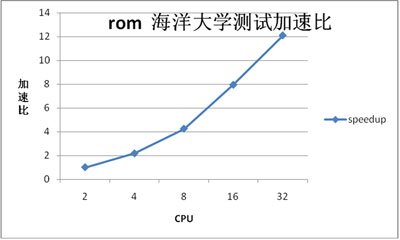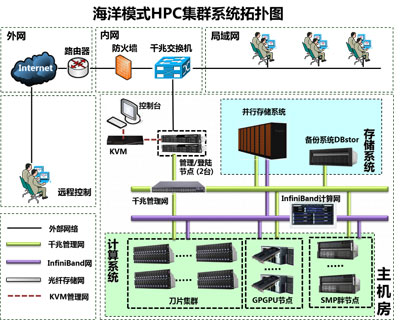
Welcome to Login
微信登录
打开手机微信,扫描二维码

扫描成功
请勿刷新本页面,按手机提示操作

中科曙光不会以任何理由要求您转账汇款,谨防诈骗

您的微信还未注册

中科曙光不会以任何理由要求您转账汇款,谨防诈骗
您可以同时关注中科曙光微信公众号
使用微信扫一扫即可登录! 查阅资料更方便、 快捷!
您已经注册账号和
关注微信公众号

2025年1月
服务热线:400-810-0466

Met-ocean and Environment
From day-to-day weather forecasting to large-scale climate research, from land to sea, from surface hydrometeorology to space weather, Twilight's high-performance computers are active. Sugon's “send” super-calculation system for the National Meteorological Administration represents the super-calculation system. Beginning to lead China's own meteorological research work, while Sugon provides technology, products and solutions for the promotion of "smart weather".
1. Oceanic mode
There is a relatively extensive design range in oceanic forecast mode, mainly including four aspects of physical oceanography, marine geology, marine acoustics and marine biology.
Physical oceanography includes ocean circulation mode, coupled mode, climate system mode, land circulation mode and regional ocean circulation mode etc, while modes involved are LICOM, ECOM, FGCOM, CSM, CCSM3, POP, MOM4, POM, ROMS, MITgcm, hycom and FVCOM etc.
Marine geology mainly involves processing of seismic data, including special pre-stack and post-stack processing; inversion of seismic data, which consists of pre-stack and post-stack inversions; seismic data interpretation, which includes general interpreting process of seismic data, 3D visualization and extraction of pre-stack and post-stack seismic attributes; production of 3Dmove equilibrium profile; as well as a large output of drawings such as seismic profile, profile of seismic attributes, structural map and inversion profile. Major softwares involved are Omega, Geoframe, Landmark, Epos, Jason and 3Dmove (UNIX, Solaris) etc.
Marine acoustics is the science that studies spreading rules of sound waves in the ocean and uses sound waves to detect the ocean. It is an interdisciplinary subject between oceanography and acoustics. Programs are mostly written by scientific research personnel themselves with content relating to parallel computing and database.
Marine biology principally carries applications of bioinformatics calculation and proteomics in marine organisms. Modes involved are Phred/Phrap, BLAST and Mascot Server (LINUX) etc.
Two representative oceanic modes that are widely applied domestically at present--ROMS and FVCOM are introduced below.
1.1 Regional Oceanic Mode ROMS
Roms (Regional Ocean Modeing System) is the regional and ocean circulation mode that is commonly used in research institutes of Oceanology; as one of the major oceanic operational modes, Roms has began to be massively used in CO-OPS, and was listed as one of the important operational oceanic modes in the following five years. Written with F90/F95, its code structure is written according to grid characteristics, supporting both sharing and distributed architectures. The application of which requires highly on cluster’s performance of each aspect with features of intensive calculation, large quantity of IO and read-write and high requirements on network bandwidth; what’s more, the application can reach preferable expansibility on the basis of problem size; when the size is small, it can accelerate to nearly 100 core; when it’s big, 200-600 core can be reached. Meanwhile, the application can also form coupled modes with other modes on meteorological ocean, or work as a driver for other meteorological oceanic applications, which is relatively common in recent tests of domestic marine agencies. Below is the test result on Sugon’s nebula system by Ocean University of China:
Grid size: 700 × 640, resolution: 6km ∼ 11km, 500s are set for each step of positive pressure; (6core/CPU)

1.2 Regional ocean current mode FVCOM
As the unstructured grid ocean circulation and ecological mode with advanced level, FVCOM mode was successfully established in 2000 by marine ecological mode laboratory in the School for Marine Science and Technology of University of Massachusetts and American Woods Hole Oceanographic Institution. It was further improved by development team of UMASS-D/WHOI mode in 2006. By integrating advantages of existing oceanic finite-difference and finite-element mode, the mode solved problems in numerical calculation such as being complex in shallow sea but matching in on shore, conservation of mass and calculating validity. It includes dry and wet network module, processing in the boundary, which abandons the original grid partition, adopts new partition method (having introduced triangular grid) and realizes accurate depiction and description of the coast, leading to quite accurate depiction on water level and tide by the mode. The mode is suitable for parallel computing and is of good extensibility.
2. Solutions
As to oceanic mode’s application characteristics such as large calculated amount, large IO read-write quantity, good parallelism and scalability, Sugon Company provides a professional and high-performance computing cluster solution, the topography of which is shown as follows:

HPC cluster hardware system is mainly composed of three parts of computing system, network system and storage system, among which computing system adopts mixed architecture of x86 computing blade plus GPGPU computing node, not only exerting the advantages of high-performance cluster computing and good parallel scalability of the blade, but also taking advantage of large-scale and ultra parallel computing of the latest GPGPU, the highest performance of which can be extended to millions of billions double precision floating-point calculation per second, so as to fully satisfy the needs of large calculated amount in oceanic mode. Network system employs “double-network” approach of Infiniband computing network and Ethernet control network; both networks are relatively independent and able to realize redundancy, to ensure the high reliability of cluster network.The cluster is configured with Sugon’s massive parallel file system, which provides massive storage reaching PB level, with the highest performance of read-write bandwidth in dozens of GB/s. To configure Sugon’s backup device of virtual tape library, backup function will be carried on crucial work and data regularly. As to users’ mode application, Sugon’s professional support team will provide technical assistance of expert level to settle users’ worries after using the high-performance cluster.
Dawning Information Industry Co.,Ltd. Sugon Building, No.36 Zhongguancun Software Park, No.8 Dongbeiwang West Road, Haidian District, Beijing 100193
Tel:+86 400-810-0466
Fax:+86 10-56308222
E-mail:international@sugon.com
Dawning Information Industry Co.,Ltd. Sugon Building, No.36 Zhongguancun Software Park, No.8 Dongbeiwang West Road, Haidian District, Beijing 100193
Tel:+86 400-810-0466
Fax:+86 10-56308222
E-mail:international@sugon.com



 Register /
Register /